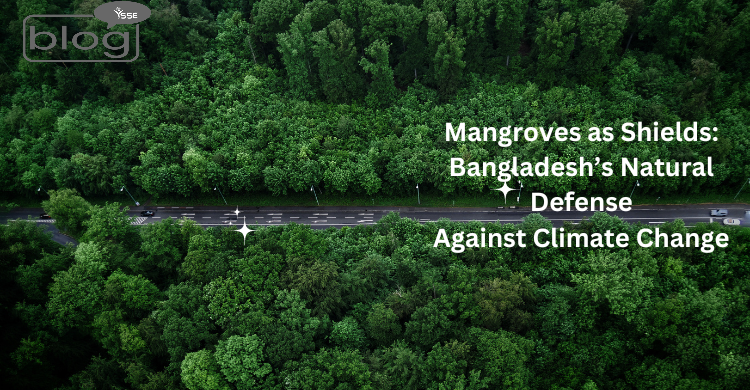Mangrove forest are forests which remain submerge in the sea. Bangladesh is blessed with the largest mangrove forest: Sundarban which is working as a silent protector for Bangladesh to tackle climate change and cyclones disaster.
Sundarban covers a vast area of bangladesh as well as India. But the major portion of the forest is located in Bangladesh. As a low land and surrounded with sea from southern said, Bangladesh is often visited by cyclones and super cyclones on a regular basis. It is Sundarban which is giving protection to Bangladesh by taking hit after hit from this disasters and still standing strong between the sea and the people of Bangladesh , thus acting as a barrier against natural disaster.
The Sundarban, act a barrier and first line of defense against natural disasters and they have once again saved the country from a storm named Cyclones-Remal. But the ecology of the forest suffered greatly as a result .While the devastating effect on the human cost of cyclones is often evident, determining the immediate effects on animals following such events is significantly more challenging. It can take some time to determine the actual number of animals death.
Apart from Sidr and Aila, a large number of trees were also uprooted in the meantime. The Sundarban face enormous challenges in the near future. There is a severe scarcity of drinking water for both local and animals because freshwater supplies are still tainted by saltwater.
The largest Mangrove Forest in the world, the Sundarban acted as a barrier against the most violent winds. The Mangrove trees’ complicated branches and leaves serve as a natural barrier that is essential in reducing storm surge height. As a result, Bangladesh and other deltaic nations are extremely fortunate to have mangrove forests along their coastlines.
In the current climate change period, Mangrove ecosystems have been quietly playing the role of our climate defender by storing and sequestering a sizable amount of atmospheric carbon, while governments are working together and setting goals to cut carbon emission internationally. According to a World Bank estimate, Indonesian mangroves store about 3.1 billion tonnes of carbon, which is the same quantity of greenhouse gases (GHGs) generated annually by billions of cars.
Mangrove forests are recognized as one of the most productive ecosystems in the world, offering coastal populations a wide range of ecosystem services. In addition to providing food supplies, fuelwood, lumber and raw materials for medicines, its diverse tree cover and nutrient-rich streams and creeks sustain a wide range of plants and wildlife. 30% of Southeast Asia’s fish harvests come from the 740 fish species that are currently know to have flourished in the aquatic environments of worldwide mangrove forests. Within its 10000 sq km of land and water, the Sundarbans mangrove forest in the Ganges delta is home to over 3000 different species of wildlife.
The International Union for Conservation of Nature (IUCN) Red list indicates that several of these species are threatened. The IUCN Red List in Bangladesh has previously classified the Bengal tiger, smooth-coated otter, saltwater crocodile and river terrapin as endangered due to changes in their native habitats brought about by anthropogenic and climatic factors.
A recent study on mangrove vegetation in nine major tropical deltas worldwide – Bangladesh , India, Pakistan, Myanmar, Vietnam, Indonesia, Tanzania, Nigeria, Venezuela and Brazil-was carried out by the Bengal institute for Architecture, Landscapes and Settlements in light of the mangrove ecosystem’s cultural and environmental values. Utilizing satellite image analysis, the study set out to look at the temporal land spatial change in mangrove regions during a thirty-year period beginning in 1991.
“The Sundarbans is not just a forest; it is a shied of protection for our coast. The forest is sacrificing parts of itself during every natural disaster while saving us.”Govt. should take necessary steps to protect this ecosystem for the betterment of future generation.
To read more blogs like this,Click here
Writer,
Tithi Rani Sarkar
Intern, Content Writing Department
YSSE

